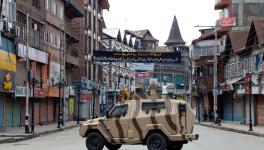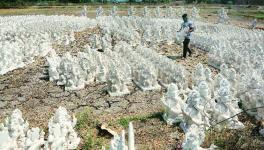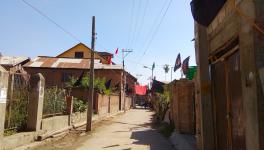For Bihar’s Tazia Makers, Every Cloud Has a Silver Lining
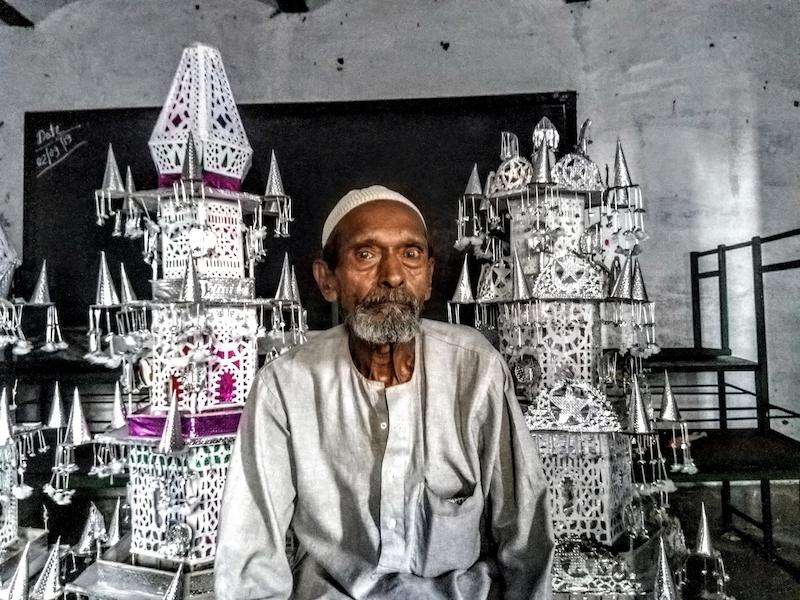
Artisan Mohammad Nizamuddin is worried about the future of his daughters as he has grown old.
People ram into dingy aisles and potholes once a year to reach the socially neglected and mostly poor scrap collectors and utensil hawkers at Imambara of Bettiah [erstwhile Bettiah Raj]. The concomitant religious solidarity of visitors gains some traction when the Islamic lunar calendar sets off for a new year.
With time, annual mourning to recognise Ashura or the day Imam Husayn was martyred in 680 CE, evolved into various cultural forms across different landmasses. The commemoration of Muharram, percolating through cultural layers of Bihar, transformed into celebration of Hussain’s passion and valour over the tragic incident that intermittently shadowed the fate of Imam, his followers and, in larger picture, Islam.
The re-enactment of Imam’s death grew to be seen through the kaleidoscope of optimism. Patronised by the progressive kings of Bettiah Raj, artisans, their descendants recount, were tasked to make a Shahi Tazia for Raj. After the art form gained momentum, processions began to be often accompanied by the beautiful Tazias or replicas of Hussain’s mausoleum, which were further made affordable, thus, available to even a poor Muharram observer.
While observers of Muharram try to demonstrate their love for Hussain as a function of the size of Tazia, it earns artisans a good diet for a month or two as well as some moments of reverie. As per local customs, clay figures of Hasan and Hussain are made by the observers. Rice is scattered on the floor of miniature mausoleums. Tazias are first carried to the local mosque where dirges are chanted. Muharram procession commences thereon.
Anwar Ali is one of many kabadiwalas or scrap collectors in Bettiah who are known for making Tazias. Zubaida Khatoon, his wife, is resisting every attempt of the customers to bargain. “Khoon-pasina baha ke bane la ee, kaise kam me degi…(They take a lot of blood and sweat; how can we sell them on an unreasonably low price…),” says Zubaida, “It has been 25 days since we started working on Tazias. My husband works, my kids work, I work…It will not even be able to do justice to labour hours we invested in them,” she adds. A customer returns unsatisfied as he fails to inch up to Rs 500 from Rs 400 for a three-foot Tazia.
This year, Zubaida’s family made 25 Tazias of medium and small sizes, with prices varying from Rs 300 to Rs 600. In the verandah, Zubaida puts a Tazia stall every year. A small poultry-keeping with some chicks swirling inside is placed at one corner of the verandah, while Tazias are aligned along the wall.
“I must shift to something else in the off season. Will this art bring me food then? I sell meat sometimes. I also collect metal scrap and sell it to recyclers, but either way, it never crosses Rs. 400 a day,” Anwar says. He sells the meat of the birds he rears. Given that he doesn’t own a commercial poultry farm, this is also an arduous job for him. Anwar’s prime source of income is scrap metal collection; he bought a cycle cart a few years ago.
On September 8, a day before the commencement of the holy hours, when this reporter visited Imambara, the kerfuffle was breaking into each lane as dusk was settling over the Urdu Girls High School, a short walking distance from Anwar’s house.
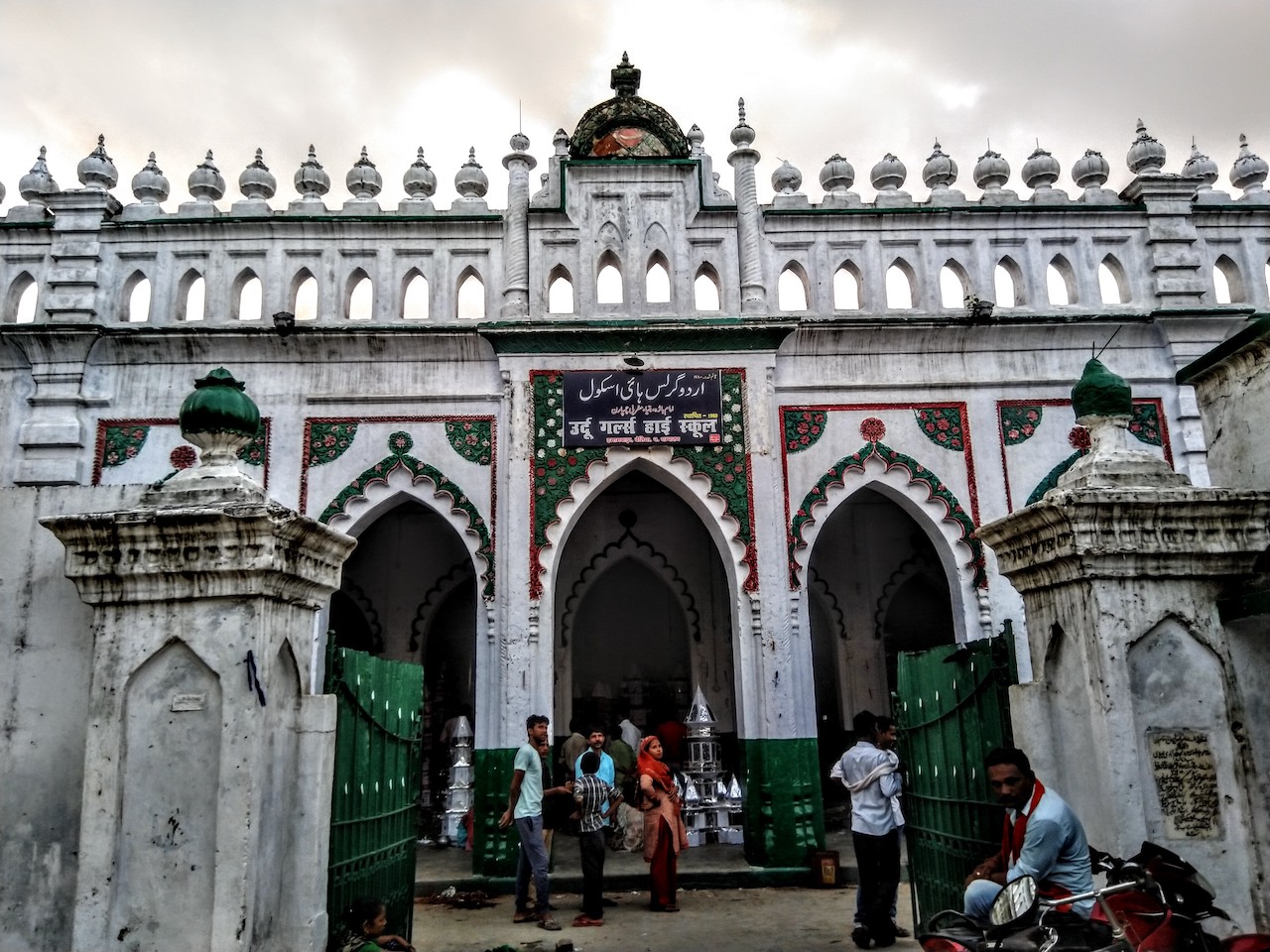
Urdu Girls High School, Imambara was opened in 1980.
Tazias are made in the premises of the high school, and are ferried to different parts of the town by middlemen or the artisans themselves, depending on the location where the stall may earn good profits. Nearly a hundred traditional artisans are dependent on this seasonal income.
The life size Tazias are yet to be given a finishing look. Mohammad Usman, in his late 50s, has occupied a classroom and the adjacent porch for arraying and exhibiting the Tazias to customers. He and his four sons have distributed the tasks amongst each other. While three of them are working on the gumbaz or dome, Usman and another son are crafting miniature mashrabiya.
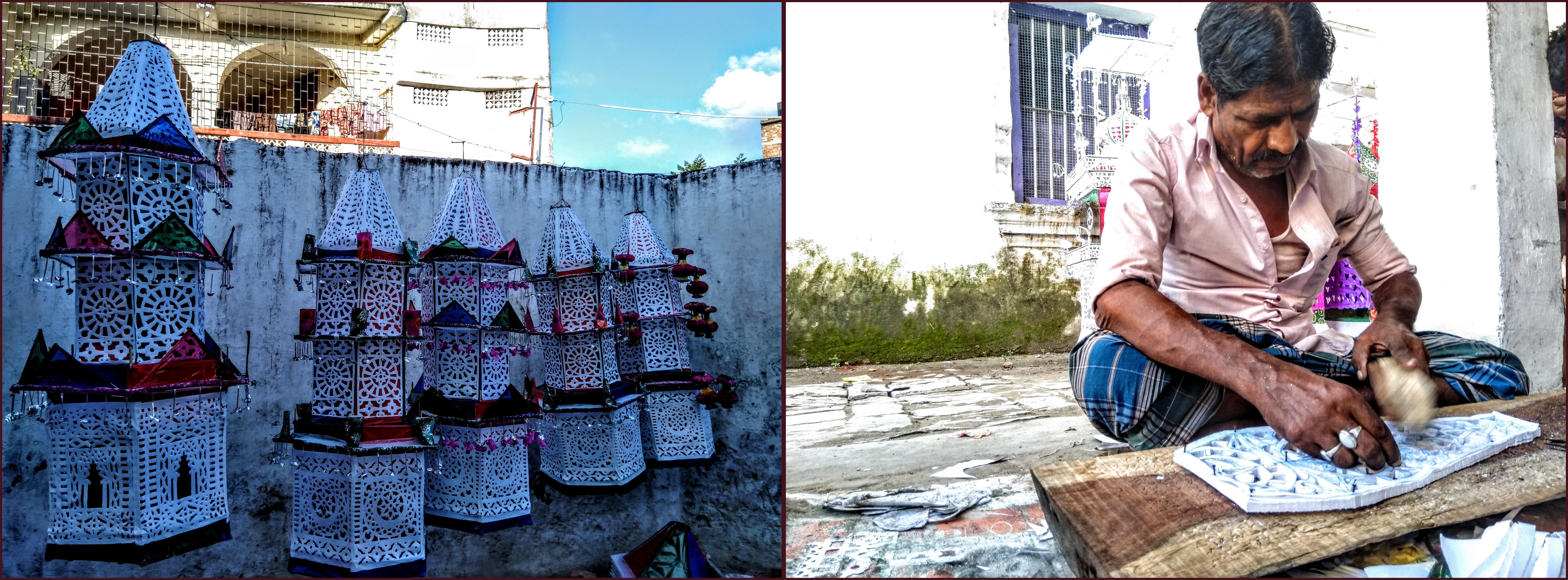
Mohammad Usman [right] has his Tazias placed outside the classroom [left] while he continues to work on mashrabiya which will adorn the life size Tazias
Making a Tazia, Usman says, is not easy, as the intricacies involved require expert skills ranging from paper cutting to bamboo and string art. “This is our traditional work, but it doesn’t help cater much for our livelihood. We must ferry aluminium utensils in the off-season, otherwise stay hungry,” says Usman, adding that the art of Tazia-making is being lost in the absence of promotion and timely assistance.
His sons, Ahmad and Ejaz, left education to support their father with the income generated from manual labour. The other two sons, Aftab and Imtiaz, attend GM Academy, a nearby school. Aftab, who has opted for commerce for intermediate examination, falls silent when asked about his future. “We will see what happens,” he says. Unfettered by the financial condition of his family, he is determined to pursue graduation. If this comes out to be a success, Aftab will be the first graduate in his family. He dreams of a career as a chartered accountant.
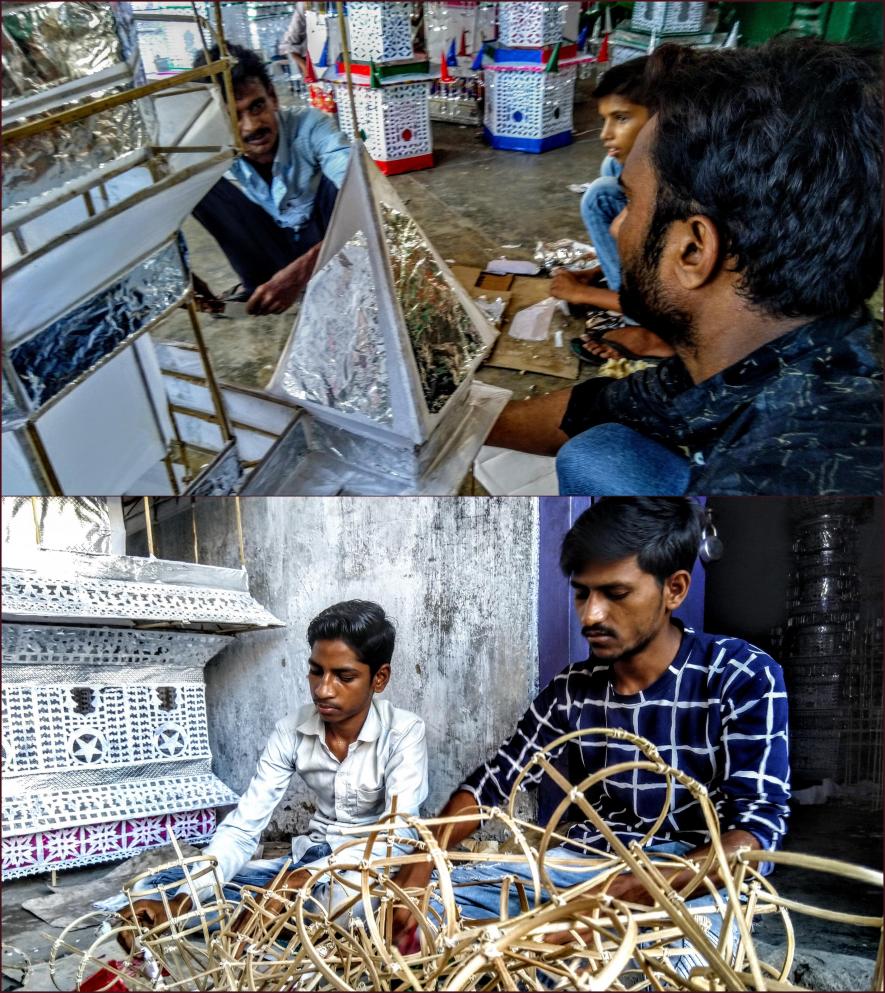
Afzal [top] and Aftab [bottom right] and Imtiyaz [bottom left] are the youngest artisans in the field of Tajia-making.
As bamboo sticks are scrunched, it makes soft crackling noise. Thread is tugged gently and wrapped around fragile sticks supported by straightened metal wires. These are the grooves which soon will become minarets tapped with colourful flimsy cones. “Kamachi banta hai bans kat ke barabar size me, bariki bahut jyada hai…(Bamboo sticks, cut in equal size, are utilised to construct frames, this work requires utmost precision…),” says Imtiaz.
Ejaz, engaged in tightening the frames, says, “At least we have this to our rescue. Otherwise, our hardships could have been worse.”
After Muharram, Ejaz, in his late 20s, will revert to the off-season job of hawker. Like his father, he also sells aluminium utensils by carrying them on a bicycle. “Somehow we manage our expenditure. I rarely make Rs 400 a day in the off-season,” says Ejaz, adding “who buys from hawkers nowadays?”
The Urdu Girls High School looks none less than a valley of minarets; however, the life of artisans goes on. Traditional artisans like Anwar and Usman have now diversified and adjusted themselves in uncanny professions, like that of a scrap collector and utensil hawker, which are not in any way connected to the domain of art they practice. The only season that eases their financial difficulties, is their religious month of mourning. While they can’t celebrate much about it, the paltry income made from Ashura helps them clear old debts incurred during Eid al-Fitr and Eid al-Adha.
“I have to pay some Rs 5,000 to shops from where I bought clothes and eateries during the festivals,” says Mohammad Bablu, 30, whose Tazias are placed in the Assembly Hall of the school. Bablu is working on the chowki or foundation of the bamboo structure of a Tazia, which he says, will take some seven more hours to finish. He neatly marks bamboo sticks with pencil. He says, “This needs dedication. If we don’t pay attention to every aspect of the Tazia, the structure will collapse in the excitement charged procession.”
Bablu’s family has made a net profit of Rs 10,000 by selling a dozen Tazias in the past two days, he expects to sell the rest the next day. Eight family members have worked tirelessly on the Tazias for over three months. “If we estimate per capita income, it will not even sustain a maximum of daily income of Rs 500 for the whole family,” adds Bablu.
Riyaz, in his late 60s, is into this field for more than 40 years now. Yet his name is not in the Bihar government’s universal pension scheme. Riyaz’s wife Tara Khatoon’s name is also not in the list, though, she is also in the eligible age group. “Kagaz patar sab ho gayil, ab batai koi tab nu…ab hamineke anpadh gawar ke kaise pata chali…(We submitted all the required documents, however, we have not been informed yet. How would we illiterates come to know about it…),” She blames Nazia Khatoon, the local ward member of Bettiah Municipality, of political apathy.
Afzal Husain, 20, who lives in Kalibag locality, too has come to place his Tazias for sale here. Like the other Tazia makers in Imambara, this is a traditional job which Afzal is now trying to assimilate. “It is improbable to imagine that a single person can make a Tazia. It requires simultaneous efforts. While I prepare glue, someone else will use the paste,” he says.
Afzal is working on a Tazia with a market value of Rs. 2,500, but “it may be sold even on a lesser price”, he adds. Afzal says, “This is the festival of truth and devotion; money doesn’t matter when it comes to faith. What will an artisan do with the money made by robbing the poor? In off-season, our situation is no different from them.”
Asgar Ali, 52, makes Jhanda [‘flag’ in Bhojpuri] or small Tazias. “Those who have been making life size Tazias will stick to it. Our ancestors harnessed the opportunity to make small size Tazias which we are continuing,” says Asgar, outlining the internal division in Tazia-making. His son Mohammad Arshad Ali, 21, is managing the stall. “I could sell only four Jhandas till now. I wish our efforts don’t go in vain,” he says, hoping to sell some 20 more of them.
“The net profit extracted from all our Jhandas will be equal to the gain a single life size Tazia will generate. In our case, we are just doing this to keep the tradition alive,” says Asgar. He tells us that he was not issued a land possession certificate by the Bettiah Block Office. “Bring receipts…bring this document…bring that document,” officers in Bettiah Block allegedly harass artisans whenever they visit them for getting possession certificates. Asgar says that most of the poor beneficiaries face the wrath of bureaucrats. “Which government office values the poor?” he says.
The problems for artisan Mohammad Manjar, the owner of the stall next to Asgar’s, are no different. His home is nearby. Six members of his family have worked for three months to make some 30 Jhandas. He is yet to make some tangible profits. Even if he makes it, that is still an annual affair for these poor artisans.
Mohammad Nizamuddin, a septuagenarian, has a son and six daughters. He is below poverty line and gets a monthly old age pension of Rs 400. Nizamuddin collected metal scrap throughout his life in the off-season, his uneducated son Mustafa, 20, does the same. Nizamuddin, a landless, lives in a rented room in the same locality. He took an informal loan of Rs 17,000 to buy raw material for Tazias. “How will we bring materials required for Tazias without a loan?”
Keeping fingers crossed, he fears any unbearable loss. Five years ago, Nizamuddin says, he faced a severe loss as some Tazias could not be sold. His stall has Tazias in three broad price ranges– Rs. 500, Rs. 1,100 and Rs. 1,500. Nizamuddin alleges that Miskar Toli Masjid of the town forcibly acquired his land some eight years ago. He was assured that he would be provided some space elsewhere to compensate the loss, but that is yet to see the light of day, NewsClick learns.
Habib Miyan, another septuagenarian, has his stall on the first floor of High School. He was allotted this space for 10 days after paying Rs 1,000. He was not given any receipt.
The Urdu Girls High School, in the initial years, served as an art learning centre in the area. Soon, it began hosting a Tazia fair on its premises. Before the establishment of school, the area was under the jurisdiction of the Imambara or the congregation ground for the followers of Islam in Bettiah Raj. While the school for girls was then started to provide them with nayi taleem or modern education, it later got engaged in protection and promotion of cultural traditions. However, this interest decreased with time. Now, each artisan is charged heavily for placing artefacts here.
“Jamil sir rahle tah kuchhu na lagat rahe…(Under Jamil sir’s authority, we were never asked to pay any kind of fee),” says Habib, remembering the generous person who stewarded artisans during his tenure as a school master.
That time has changed with the advent of modern digital era makes no difference to Habib, who still rides a cycle-rickshaw in the off-season.
Habib Miyan and his wife Sakuna Khatoon, 65, receive the old age pension, but, for that, they were asked to bribe the official in Bettiah Block. Sakuna says, “We were asked to place Rs. 1000 between application slips. Only when we did this, it was sanctioned.” Sakuna’s pension disbursement could only be proffered this year. There is no system in place to hold local representatives accountable if the names of eligible beneficiaries don’t find a place in the official list.
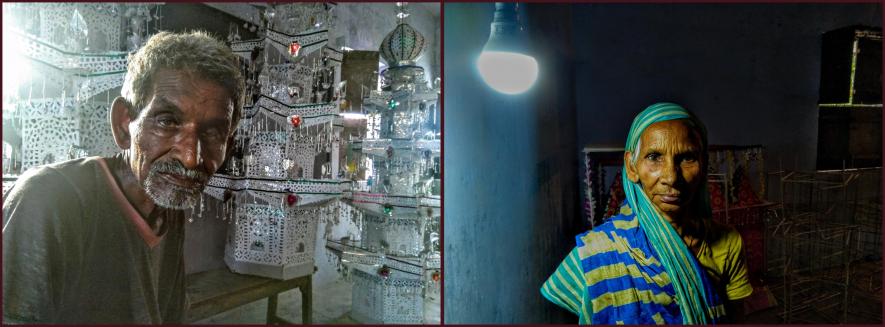
Habib Miyah [left] and wife Sakuna Khatoon [right] live in a rented room as they have failed to produce land possession certificate for a piece of land they inherited.
Habib Miya has only 3 dhur or 546 sq. ft. of land as a share in the ancestral property, he has no possession certificate. He was asked to pay a bribe of Rs. 30,000 for it. As he couldn’t afford it, he had no option except to leave the place. He now lives, like Nizamuddin, in a rented room in the locality. Habib, his wife Sakuna, son Akbar Ali, daughter-in-law Rehana Begum and Habib’s three grandchildren live in a nearby slum for which they pay a monthly rent of Rs 1,000.
Akbar Ali is a scrap collector. He has a handcart. Also, he pulls a cycle-rickshaw. Some seven Jhandas had to be prepared by Akbar’s family on the day this reporter visited them, which was their last chance to make some money. Akbar, his wife, along with his parents work on Tazias. The exercise begins four months before Muharram. “The most important component of Tazia is ‘bamboo’. Because of the rising prices of bamboo, the sale of artefacts is facing critical strains. The price of decorative papers too has increased. We are now being charged for placing artefacts here, our family needs have risen…for how long we can continue with these difficulties?” says Akbar, adding that some financial assistance from NGOs or government could help artisans like him.
Akbar’s daughter Saheen Parveen studies in Class 2 in a nearby private school. The monthly fee at the school is Rs. 300. Asked about her ambitions, Saheen says she wants to be doctor, as she scuttles across the school corridor to play with the friends. Among the children of artisans is one Mohammad Saddam, 10, who left schooling some three years ago to help his father collect metal scrap. “I have not thought much about the future,” says Saddam whose family is facing a financial crunch. He is not interested in re-joining the school.
Rehana Begum says the names of her children are not linked with public distribution system or PDS as beneficiaries. She also alleges that the local Anganwadi Centre hasn’t distributed uniforms yet. The ration, she says, is usually adulterated. Only after some scuffles with PDS, it was possible for Rehana to receive adequate amount of ration. “Some women were telling me that the government is opening bank accounts for girl children…I have no idea about it,” says Rehana, adding that local ASHA or Accredited Social Health Activist doesn’t care to inform them about the latest schemes.
On our way back, we find Anwar Ali’s son Imtiaz, who tells us that he studies in Class 6 in a government school near Joda Inar landmark. He says he is more interested in sports, however, his school doesn’t have the necessary infrastructure.
As he jumps over a pile of household waste, he says “Municipal vans rarely come in our area to pick up garbage. It stinks”, giving us a little hint about the defining characteristic of the ghettoisation.
Ujjawal Krishnam is an independent journalist. He reports on social inequality and rights.
Get the latest reports & analysis with people's perspective on Protests, movements & deep analytical videos, discussions of the current affairs in your Telegram app. Subscribe to NewsClick's Telegram channel & get Real-Time updates on stories, as they get published on our website.











